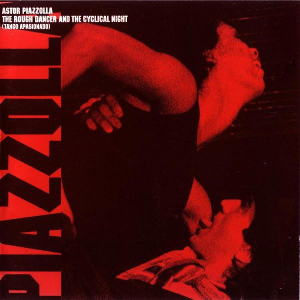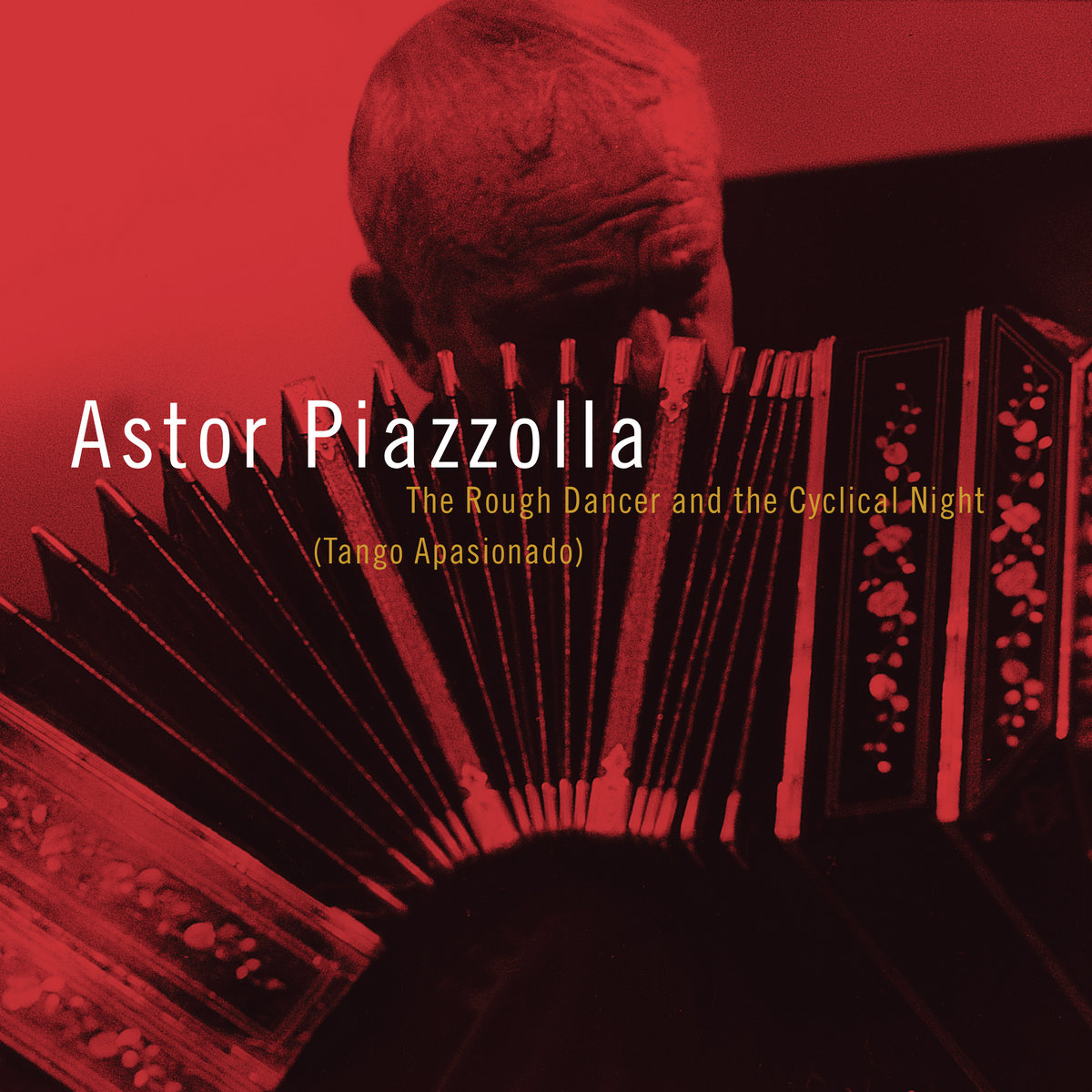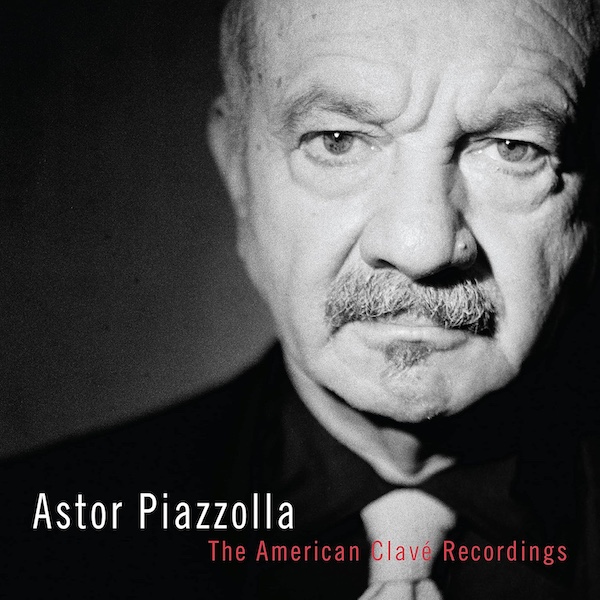Borges Music – Piazzolla “Rough Dancer and the Cyclical Night”
- At August 15, 2018
- By Great Quail
- In Borges
 0
0
This, here, is Buenos Aires. Time, which brings
Either love or money to men, hands on to me
Only this withered rose, this empty tracery
Of streets with names recurring from the past
—Jorge Luis Borges, “The Cyclical Night”
The Rough Dancer and the Cyclical Night
(1987–1988)
For tango orchestra
- Prologue (Tango Apasionado)
- Milonga for Three
- Street Tango
- Milonga Picaresque
- Knife Fight
- Leonora’s Song
- Prelude to the Cyclical Night (Part One)
- Butcher’s Death
- Leijia’s Game
- Milonga for Three (Reprise)
- Bailongo
- Leonora’s Love Theme
- Finale (Tango Apasionado)
- Prelude to the Cyclical Night (Part Two)
This cycle of fourteen dances was commissioned by the Hispanic American Arts Center for their production of Graciela Daniele’s Tango Apasionado. Inspired by Borges’ stories “The Intruder” and “Streetcorner Man,” Tango Apasionado was a seventy-minute performance that merged music, dance, and theater. Premiering in New York City in 1987, the New York Times described Tango Apasionado as an “entire Borges landscape…a labyrinthine world that is, at once, erotic and bloodthirsty.”
The following year, Astor Piazzolla and Kip Hanrahan of American Clavé reimagined the music as a stand-alone suite. Drawing additional inspiration from Borges’ 1940 poem, “La noche cíclica,” The Rough Dancer and the Cyclical Night was conceived as a “nostalgic dream” of turn-of-the-century Buenos Aires, the mythopoetic city of Borges’ Fervor de Buenos Aires and Evaristo Carriego. According to Piazzolla, he wanted the recording to evoke a group of “half-drunk musicians in a bordello,” and ordered the engineers to keep the production low-fidelity.
Rough Dancer opens with the lilting theme named for the original production, “Tango Apasionado.” At first blush, it feels like classic Piazzolla—the familiar bandoneón is there, of course, riding atop a staggering piano and interrupted by rusty bursts of pizzicato. But where typical Piazzolla is known for crispness and vigor, “Tango Apasionado” unfolds with delicious laziness, like a sleepy cat flexing its claws. This leads into the beautiful “Milonga for Three,” a weary lament filled with longing and hesitation, the singer replaced by a slurred bandoneón. There’s an intimacy in this music that conveys a haunting sense of familiarity, as if the band has been together for years and knows the secrets of every regular at the bar. They cast a spell of nostalgia so powerful that even anachronistic elements—fragments of jazz saxophone or doleful lines of electric guitar—are seamlessly absorbed into the timeless dream. Much as Borges’ poem “The Cyclical Night” ends with the first line repeated as a quotation, Rough Dancer concludes with an enervated reprise of the tango that introduced the suite, followed by a short coda incongruously labeled as a “Prelude.”
Rough Dancer is not an album suitable for daylight. This is music for starless nights and flickering street lamps, snatches of song echoing down an unfamiliar street; music for insomniacs not ready for dawn, stumbling from midnight cabarets into the pitiless madrugada. This is music for a night that seems like a hallucination by daybreak. Its siblings are In the Wee Small Hours and Nighthawks at the Diner, and its venue is Club Silencio—or that place you swear used to be there, just around the corner, when you first visited the city twenty years ago. While Buenos Aires may be its inspiration, Rough Dancer and the Cyclical Night speaks to anyone yearning for a lost time and place. As Borges writes in “The Mythical Founding of Buenos Aires”—
Hard to believe Buenos Aires had any beginning.
I feel it to be as eternal as air and water.
Liner Notes
By Fernando Gonzales
The Rough Dancer and the Cyclical Night
American Clavé, 1988
This album, is a labyrinth of glass and mirrors. Here is Piazzolla retracing tango’s history back to the piringundines, the whorehouses in the outskirts of the old Buenos Aires. As the music grows, Piazzolla imagines Jorge Luis Borges imagining a muddy and baroque world of cuchilleros and compadritos, fast knives and fast dancers, rough milongas and rougher camas. Here is also Piazzolla looking back at Piazzolla. And as he does so, traces of old melodies, familiar gestures and what is to come, turn around and around in a tight embrace, like dancers. The setting is the turn of the century, yet the music announces what Piazzolla will be doing 50, 60 years later. Time, here, is circular. Somewhere in the shadows, Borges, with an ironic smile, approves.
By Producer Kip Hanrahan
El Indio (Suerez Paz) and I were in the studio early one morning trying to run down some rough edges when El Troesma (Piazzolla) burst through the door (really, life sometimes does follow the gestures of a B movie). “What the hell do you two think you’re doing? Nancy told me you were here and I told her that if you try to ‘correct’ anything I’ll shoot you!” Hey, here’s this guy who, when we were recording TANGO: ZERO HOUR, would argue with us for days about whether a violin decay sounded as good as it actually was. “Yeah, but ZERO HOUR needed the clarity of a vision, this record needs the darkness of a nostalgic dream. It’s music meant to be played by half-drunk musicians in a bordello,” he said, glancing around the recording studio. “Turn it into chamber music and you’ll be eating dinner with Borges tonight.” El Indio no doubt shrugged and muttered something about his deity and how he’ll never be able to anticipate El Troesma del Nuevo Gotang, I probably laughed, and Astor offered to take us out for a drink. Turn of the century Buenos Aires was never a geographical or historical location, just consult Borges’ books. On that September morning in 1987 in New York, we were passing through it just in the way a porteño genius demanded his milongas cruel.
Borges Poem
Cyclical Night
They knew it, the fervent pupils of Pythagoras:
That stars and men revolve in a cycle,
That fateful atoms will bring back the vital
Gold Aphrodite, Thebans, and agoras.
In future epochs the centaur will oppress
With solid uncleft hoof the breast of the Lapith;
When Rome is dust the Minotaur will moan
Once more in the endless dark of its rank palace.
Every sleepless night will come back in minute
Detail. This writing hand will be born from the same
Womb, and bitter armies contrive their doom.
(Edinburgh’s David Hume made this very point.)
I do not know if we will recur in a second
Cycle, like numbers in a periodic fraction;
But I know that a vague Pythagorean rotation
Night after night sets me down in the world
On the outskirts of this city. A remote street
Which might be either north or west or south,
But always with a blue-washed wall, the shade
Of a fig tree, and a sidewalk of broken concrete.
This, here, is Buenos Aires. Time, which brings
Either love or money to men, hands on to me
Only this withered rose, this empty tracery
Of streets with names recurring from the past
In my blood: Laprida, Cabrera, Soler, Suarez…
Names in which secret bugle calls are sounding,
Invoking republics, cavalry, and mornings,
Joyful victories, men dying in action.
Squares weighed down by a night in no one’s care
Are the vast patios of an empty palace,
And the single-minded streets creating space
Are corridors for sleep and nameless fear.
It returns, the hollow dark of Anaxagoras;
In my human flesh, eternity keeps recurring
And the memory, or plan, of an endless poem beginning:
“They knew it, the fervent pupils of Pythagoras…”
—Jorge Luis Borges, 1940
Recordings
 |
 |
 |
The Rough Dancer and the Cyclical Night
LP: American Clavé AMCL 1019 (1988)
CD: American Clavé AMCL 1019 (1988)
Reissue CD: Nonesuch 7559-79515-2 (1991/2000)
Compilation CD: The American Clavé Recordings. Nonesuch 0075597915280 (2022)
Purchase Rough Dancer: 1988 CD [Amazon], 1991 CD [Amazon], Digital [Bandcamp]
Purchase American Clavé Recordings: CD [Amazon], Digital [Bandcamp]
Online: YouTube [Album Playlist]
Musicians
Astor Piazzolla, Bandoneón
Pablo Zinger, Piano
Fernando Suarez Paz, Violin
Paquito D’Rivera, Alto sax, clarinet
Andy Gonzales, Bass
Rodolfo Alchourron, Electric Guitar
The Rough Dancer and the Cyclical Night was released on LP and CD by American Clavé in 1988, then again on compact disc by Nonesuch in 1991 and 2000. In 1993 American Clavé produced a 3-CD set called Piazzolla—The Late Masterpieces: The Complete Work on American Clavé, AMCL 1022. It collected Piazzolla’s three 1980s American Clavé masterpieces produced by Kip Hanrahan and performed by members of the Quinteto Nuevo Tango: Zero Hour, La Camorra, and The Rough Dancer and the Cyclical Night. These recordings were remastered in 2009, and are now found on the Nonesuch collection Astor Piazzolla: The American Clavé Recordings, available on compact disc and vinyl.
Online Video
Rough Dancer and the Cyclical Night
Ensemble Nueva Pasión
Recorded in 2021 in Hamburg’s Mozart Halls by VMTV.

 Additional Information
Additional Information
Stage: Borges Stories In “Tango Apasionado”
From The New York Times, 10 November 1987. A review and discussion of Graciela Daniele’s Tango Apasionado.
Rough Dancer at Brave New World
The Brave New World blog has a lovely post on Rough Dancer by Carl Sheever.
Reconsidering the Collaboration Between Piazzolla and Borges
This paper by John Turci-Escobar explores the oft-contentious “collaboration” between Borges and Piazzolla. It appeared in Variaciones Borges No. 31, and is available from the Borges Center. [PDF]
Astor Piazzolla’s Borges-Related Works
Astor Piazzolla Main Page
Return to the Garden of Forking Path’s Astor Piazzolla profile.
El tango (1965)
Piazzolla set some of Borges’ poems and milongas to music on the album El tango.
María de Buenos Aires (1968)
Piazzolla’s great tango operita, this surreal work was a collaboration with poet Horacio Ferrer. Although not directly related to Borges, its themes are often reminiscent of Borges’ early work.
A intrusa (1979)
Piazzolla’s score to A intrusa, a homoerotic Brazilian movie directed by Carlos Hugo Christensen and loosely based on Borges’ story “The Intruder.”
Borges & Piazzolla (1996)
A modern remake of El tango, this exuberant album brings Borges’ mythical Buenos Aires to life through music, song, and narration.
Author: Allen B. Ruch
Last Modified: 7 August 2024
Borges Music Page: Borges and Music
Main Borges Page: The Garden of Forking Paths
Contact: quail(at)shipwrecklibrary(dot)com

